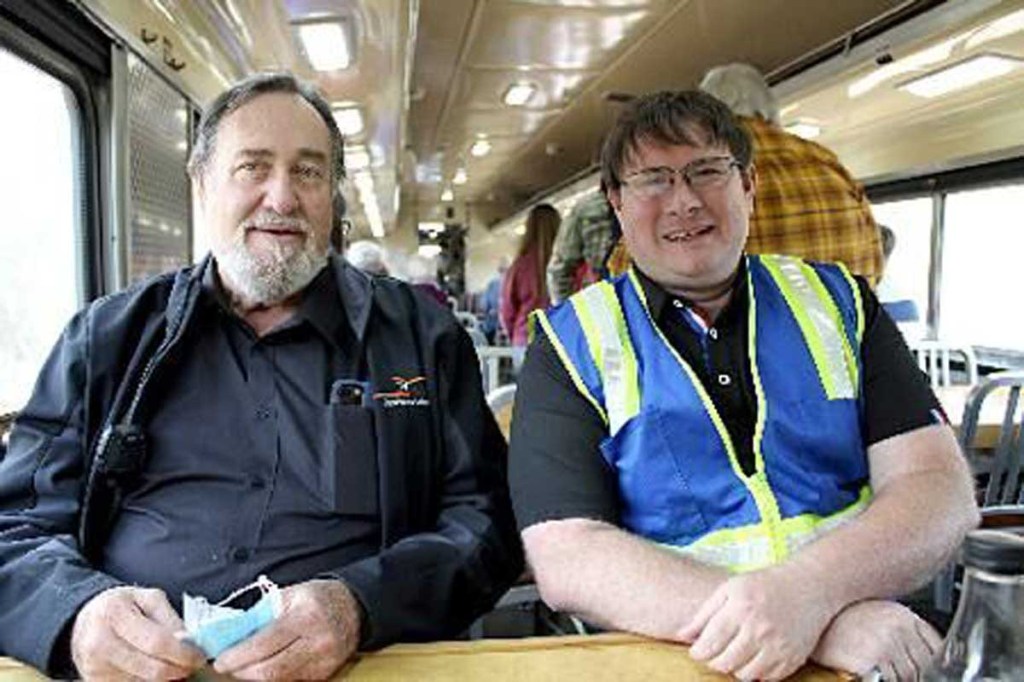Riding the Rails: Excursion train offers ride on classic passenger coaches
Published 6:00 am Saturday, March 27, 2021

- Terry Richards | The Valdosta Daily TimesJamie Cater and Chris Parrot, co-CEOs of CaterParrott Railnet, sit in the Azalea Sprinter's table car.
NASHVILLE — Vincent Bister was standing in the table car, waiting for the train to pull out of town.
A resident of Lakeland, Fla., he brought his high-end Canon camera and its lengthy lens to Nashville to further his hobby.
“I’m a train buff,” he said. “I grew up around trains; my dad was retired from the railroad.”
Likewise, George Fisher, of Hahira, is a train enthusiast. He brought his grandson James, 4, to Nashville March 19 to ride the new Azalea Sprinter excursion train.
“I’ve ridden trains all over the world,” Fisher said. “Europe, Asia, China, Canada …”
Bister and the Fishers were among more than 70 passengers that day on the CaterParrott Railnet train, taking riders through the woods of Berrien and Atkinson counties on classic restored passenger rail cars.
CaterParrott Railnet is a shortline railroad serving 11 counties in South Georgia. Most of the trains rolling over CaterParrott’s rails are freight trains, but the company’s leaders wanted more.
“Jamie (Cater) and I wanted to move people,” said Chris Parrott. Cater and Parrott are the co-CEOs of the firm and were both on the Azalea Sprinter March 19.
“The name of the train came from the azalea, the official flower of Valdosta, they’re all over the place,” Parrott said. “And ‘sprinter’ suggests efficiency and cleanliness.”
The train included a coach car with seats, a table car with a snack bar at one end and a caboose with hardwood floors for the first-class passengers, plus locomotives at each end of the train.
The rail system had to be upgraded for passenger traffic in 2020 and will be improved again this year, Cater said. Parrott said the Azalea Sprinter was the first passenger train to call on Nashville since 1947.
The two passenger cars were obtained from “a group in Wyoming,” Parrott said. The cars were refurbished and offered air conditioning and restrooms, including one that’s wheelchair accessible.
Both the coach car and the table car were built by the Budd Company, which, from the 1930s to 1987, was the major competition for the famed Pullman Company in the construction of passenger train cars. Budd’s passenger units were noted for their Art Deco-influenced stainless steel “streamliner” design.
Until 1971, all intercity passenger trains in the U.S. were operated by private railroads. With the rise of automobile ownership and jet service in the 1950s and 1960s, passenger rail suffered a sharp decline in ridership and the railroads wanted out of the business.
In 1971, the federal government launched Amtrak, a quasi-public organization to take over most intercity passenger train service. As a result, some passenger cars were transferred to Amtrak, while others were sold by the railroads which no longer needed or wanted them.
CaterParrott’s coach car, the Golden Surf, had previously seen service with Amtrak’s train Hoosier State on the Chicago-Indianapolis run, Parrott said. The car also carries the name Royal Palm — the name of a former Southern Railway Chicago-Florida passenger train that stopped in Valdosta until 1967.
Under way
The Azalea Sprinter was parked on the tracks between the Nashville Farmer’s Market and a daycare center as it took on passengers. About 72 people had purchased tickets for that day’s excursion, Parrott said.
“We have room for more, but with social distancing (for the COVID-19 pandemic), we’ve been underselling the train,” he said.
As the Sprinter started rolling, the children in the daycare gathered alongside a fence to wave the train goodbye.
The rails took the train at a leisurely pace through the woods and over streams and past lakes on its way to Willacoochee, passing the occasional cluster of homes on back roads. It followed part of the route of the old Georgia and Florida Railroad, which operated in one form or another from 1906-71, with rails from Madison, Fla., to South Carolina.
Seats in the coach car were the least expensive at $32.25; seats in the table car ran for $47.40 and included free sodas and snacks (coach passengers could purchase these separately). The luxury caboose costs almost $400 for six people.
Parrott said the available seating has been selling out for all of the train’s outings.
CaterParrott is close to obtaining a full dining car, with a compete kitchen, Parrott said.
“The table car is really complimentary to a dining car,” he said. The dining car — essentially a restaurant on wheels — would allow the company to offer dinner excursions and couples retreats, he said.
“We’re talking about ribeye, lobster and live entertainment,” Parrott said.
The firm has also acquired a classic Pullman sleeper car — a small hotel on wheels — which had seen service on Southern Railway’s New York-New Orleans train the Southern Crescent, which ended its run under “the Southern” in 1979, only to be transferred to Amtrak operations that year.
The sleeper car is sitting in CaterParrott’s Tifton facility awaiting upgrades, Cater said.
In the future
After about 18 miles, the Azalea Sprinter slowed to a stop on the rails in Willacoochee; the locomotive on the back of the train allowed for a return to Nashville on the same route.
“The reaction to the train has been splendid,” Cater said.
“Our goal is to bring people into the area, spurring economic growth. As people come for the train, they’ll spend money in local businesses,” Parrott said.
While most of the train’s trips will be on the Willacoochee run, future plans include runs to Valdosta and “pizza express” specials, with the train running from Nashville to Moody Air Force Base with food from a local pizzeria provided, he said.





